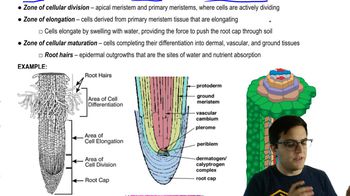33. Plant Anatomy
Growth
Learn with other creators
Practice this topic
- Multiple ChoiceIf you wanted to plant a flowering plant in your yard that would bloom every spring, which of the following should you choose?903views
- Multiple ChoiceA region of dividing cells in a plant is called a __________.1181views
- Multiple ChoiceWhich example below is the site of primary growth that results in the plant's increasing in height?980views
- Multiple ChoiceWhich of the following is a lateral meristem?1364views
- Textbook Question
Most of the growth of a plant body is the result of
a. Cell differentiation
b. Morphogenesis
c. Cell division
d. Cell elongation
1147views - Textbook Question
Heartwood and sapwood consist of
a. Bark
b. Periderm
c. Secondary xylem
d. Secondary phloem
1552views - Textbook Question
How are Okazaki fragments synthesized?
a. By using the leading-strand template, and synthesizing 5'→3'
b. By using the leading-strand template, and synthesizing 3'→5'
c. By using the lagging-strand template, and synthesizing 5'→3'
d. By using the lagging-strand template, and synthesizing 3'→5'.
1189views - Textbook Question
Which statement best characterizes primary growth?
a. It does not occur in roots, only in shoots.
b. It leads to the development of cork tissue.
c. It produces the dermal, ground, and vascular tissues.
d. It produces rings of xylem, phloem, and cork tissue.
461views




















